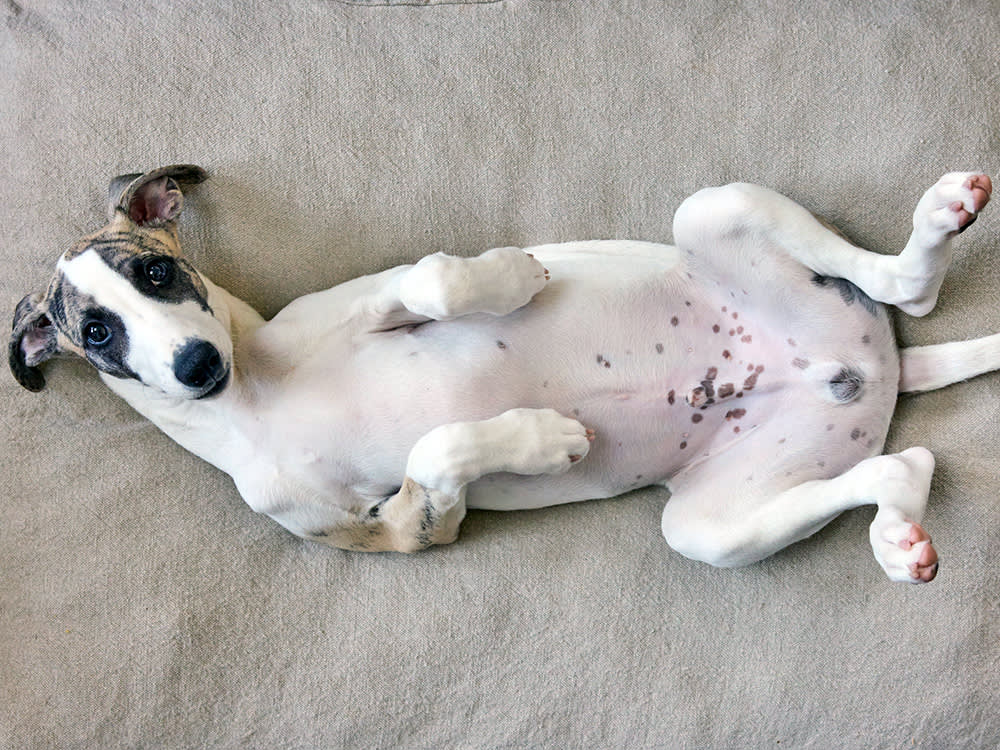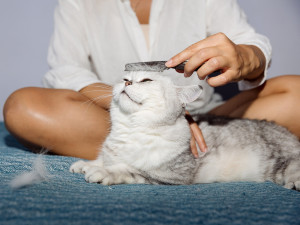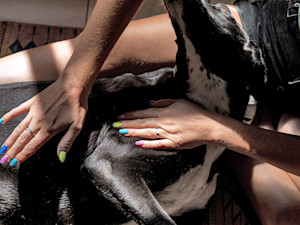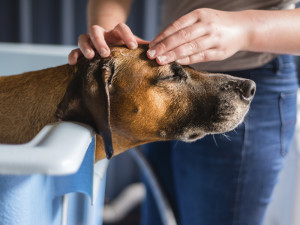Black Dots On Your Dog Or Cat? Here’s What You Need to Know
We’re not talking about Dalmatians here – they can have all the spots they like
In this article:
What are black dots on a pet’s skin? Causes of black dots Identifying black dots on your pet’s skin Are black dots on your pet’s skin dangerous? Treatment and management Preventing black dots Frequently asked questions
Black dots on pets are a commonplace pet issue. But we’re not talking about Dalmatians here – they can have all the spots they like. I’m talking about the small specks and dots you might’ve noticed on your pet’s skin, either whilst grooming or in the midst of cuddles on the sofa. Here, we look at the main causes of black dots appearing on your dog or cat’s skin. These pesky things can be very hard to see, so get your glasses and read on to find out what you’re looking for – and more importantly what you can do about them.
What are black dots on a pet’s skin?
There are several reasons you might notice black dots on your pet’s skin, some are normal and nothing to worry about, whereas others may need treatment. Let’s start by having a brief look into the most common reasons behind the black dots:
Blackheads – common in people, common in pets!
Flea ‘dirt’ – tiny bits of flea faeces left behind on your pet.
Scabs – from small injuries.
Hyperpigmentation, including from:
normal freckles
bacterial or fungal skin infections
hormonal imbalances
There are several reasons for black dots to appear on your four-legged friend’s skin, but there are also other things that may look similar, but are actually other skin conditions such as warts, moles or melanomas. These conditions can all start as small dots on the skin but grow and change shape (sometimes rapidly), can appear flat or raised, and are usually larger than small black dots. If this is something you notice, it’s best to get in touch with your vet.
Causes of black dots on a pet’s skin
Blackheads
Also known as comedones, blackheads in pets are small pimple-like spots on the skin. Think of them like the blackheads found on human skin and caused by the same issue: sebum, oil and normal debris clogging the pore.
There are other reasons these pores get blocked, too. For example, seborrhoea is a skin disorderopens in new tab in which the sebaceous glands of the skin produce an excessive amount of sebum, causing scaly, flaky, itchy skin and more pores getting clogged.
Another cause of blackheads in pets is tiny mites called Demodex that live in the follicles. Sometimes they can get too big for their boots and multiply to extreme numbers, causing more blocked pores and other skin irritations.
Hormonal imbalances from issues such as Cushing’s Disease (hyperadrenocorticism) can create more comedones to appear on your pet’s skin; excess comedones along with other bodily changes can actually help lead to early detection and diagnosis of the condition.
Flea ‘dirt’
Flea dirt is the tiny specks of dried blood and other excrement from fleas – super gross but super common. Often we don’t find live fleas on our pets, but we know they’ve been there from the dirt left behind.
Flea dirt appears as small little flecks within your pet’s fur – it’s mobile, ie, not attached to the skin, and can be picked out. To work out if it’s flea dirt or normal dirt, try brushing the affected area their coat onto a white tissue or paper, then add a drop of water and smear the dirt – if it turns slightly pink or brown then we have flea dirt, and what you are seeing is the dried blood being smeared.
More often than not it’s a case of when our four-legged friends get fleas, not if, so don’t feel down about noticing an outbreak and shy away from telling your vet – we’ve all been there and there are several ways of tackling the pesky things.
Scabs
Small injuries create small scabs. These can be from things such as insect bites, thorns or the rough play time between pets. You will usually notice scabs while they are attached to the skin, but sometimes they can be caught up in the fur once they shed.
Hyperpigmentation
Freckles just like ours can be found on the skin of our pets and they are usually there from birth. And, just like ours, they’re mostly harmless but they should be monitored for any colour changes or growth.
However, sometimes other health issues can cause hyperpigmentation such as skin infections from bacteria or fungal pathogens. Any red or darker new patches of skin should be examined by your vet to check for infection or any underlying issues such as hormonal imbalances. Usually after treatment the skin changes go back to normal. (Hormonal imbalances don’t just mean reproductive hormones, but can also include the many other hormones in your pet’s body working hard to regulate skin and body homeostasis).
Identifying black dots on your pet’s skin
The only way to know if your pet has black dots on their skin is by examining them carefully. Some of these dots are so small they can be hard to see, so make sure you inspect them in good lighting and you can even use a camera with the zoom function to help.
The darker the animal, their fur and/or their skin increases the chances the dots may be missed, so using a torch or brushing the spots onto a light coloured towel or tissue may help you spot any that are loose. Here’s a few more tips on how to identify the black dots on your pet’s skin:
Freckles and hyperpigmentation will appear flat against the skin. They will be fixed and won’t budge if you try to clean them off.
Flea dirt can move easily on the skin. It can get lodged in the fur but the hard crusty dots can be brushed out.
Comedones are part of the skin, but when cleaning the skin the blackhead part of the clogged pore may come loose and be able to be cleaned away. This is the sebum oil and collected debris that builds up in the pore.
Look out for any other symptoms of infection or underlying issues; redness, itching, inflammation or a yeasty smell to the skin (with or without black dots) are signs you want to talk to your vet about.
Are black dots on your pet’s skin dangerous?
While normal black dots such as freckles are nothing to worry about, some of the other causes of black dots need treatment to tackle them. If you are in any doubt over black dots on your pet’s skin talk to your vet, especially if there are other symptoms you are concerned about.
If left untreated, fleas and their dirt can become a health concern, particularly in very young, old or infirm animals. This is because they feast on blood, which can cause severe anaemia and make them very unwell. Tackling the underlying flea infestation in the home and on your pet’s skin will stop fleas from becoming more of a severe problem.
Hormonal conditions such as Cushing’s Disease (hyperadrenocorticism) that cause skin colour changes and comedones, also cause lethargy, muscle wastage, increased thirst and urination, can lead to kidney damage and can be life-threatening if left untreated. So whilst the black spots themselves might not be severe in this instance, they can be a sign of something underlying that’s much more serious.
Another health concern is when small black dots become big black dots; always get any spots checked out by your vet if there is change in colour, size or texture as issues such as melanomas can start small and are best to catch as early as possible.
Other signs to check for are behavioural changes in your pet, such as excessive licking or biting at a black dot, as well as physical changes, such as any irritation or bleeding and signs of infection such as discharge or pus. If you notice any of these changes make an appointment with your vet to see if any investigations or treatment is necessary.
Treatment and management options for black dots on pets
At home
At-home care is very important when it comes to your pets skin health. Giving them the once-over by visually inspecting them and regularly feeling their skin through gentle stroking – and parting the fur in places to look underneath – is a good way to check for any black dots while also creating bonding time with your pet under the guise of grooming.
If you notice some black dots try to see if they can be brushed away like normal dirt and flea dirt can, or if they are attached to the skin like freckles and blackheads. If they come away, test for blood tingeing as discussed before. If the dots remain, try using a gentle pet-safe skin cleanser to wash the skin, if they then come away they may be clogged pores and if not they are most likely skin colour changes which should be monitored and flagged to your vet if new or changing in any way.
Medical
If your pet needs any medicated shampoos or topical treatments, these would have to be prescribed by your vet. Skin issues can be a long-term battle and so costs can add up, depending on your local practice prices diagnostics such as skin scrapes, biopsies and blood tests can range from £20 through and beyond £300+ depending on the location and level of diagnostics involved.
Treatment options also vary in price, with the non-medicated shampoos being around £10+ over the counter to extensive systemic treatment, such as antibiotics or allergy treatments such as Cytopoint injections, which can cost £200+ monthly if needed long term. Don’t let these costs scare you too much, as the most common ailments of the skin are preventable and are easily treatable if caught early.
Preventing black dots on your pet’s skin
With so many reasons little black dots appear on your pet’s skin, some things put animals at a higher risk of specks showing up but here’s what you can do about it.
Flea treatment
Not being up to date with – or using inappropriate – flea treatment increases the risk of getting infestations. Some flea treatments only kill adult fleas and some pet parents find fleas persisting even after using medication. The most potent and effective flea medication has to be prescribed by your vet as a physical examination of your pet has to be performed to ensure the medication is safe and appropriate for them. If you notice persistent fleas on your pet even with flea treatment talk to your vet as getting prescription based medication may be needed.
Appropriate flea and mite control is very important all-year round. This includes ‘indoor-only’ pets as well as ones that explore outside. For the most effective flea control it is recommended to get treatment through your vets with a prescription and they can be in the form of spot-on topical treatment or oral tablets. Depending on the brand, treatments can be monthly or three-monthly treatments.
Ensure all pets in the house are treated and also treat the house and any soft furnishing (beds, blankets, cat trees, etc.) if an infestation occurs through house flea sprays. (Please read the safety precautions on the pack as these sprays can irritate human and animal lungs if inhaled).
Grooming
Regular grooming benefits the skin through increasing blood flow to areas, exfoliating dead skin cells and debris away from the surface and allows time to check for any sore spots or changes (plus gives you and your pet that well-earned bonding time).
Maintaining a good skin care and grooming regime with your pet is highly useful to monitor any changes in the skin and also acts as at home treatment for the minor issues such as clogged pores. Always use pet-safe shampoos and cleansers, and only bathe your pet when necessary to allow their skin to remain healthy and to not take away their natural oils too much.
If grooming and bathing techniques at home aren’t enough, there are many great grooming businesses that are available for an extra special pamper for your pets. Finding the right groomer for your pet can be very useful as not only do they leave your pet smelling amazing but they are also another pair of eyes that know your pet’s skin and can flag any issues they notice.
Lifestyle
Maintaining a good diet can help with skin issues flaring up or prevent them altogether if allergies or nutritional deficiencies are the cause. Using ‘complete’ dog and cat food ensures all their nutritional needs are met, and if you have any questions over your pet’s individual needs talk to your vet about the best diet for them.
Regular check-ups
Other risks of seeing black dots include; improper skin hygiene, excess sebum production through allergies or skin issues, and untreated skin infections or wounds. Hormonal imbalances and common skin issues occur most often in older animals so the risk of black dots can increase as your pet gets older. Don’t be afraid to flag any issues to your vet to ensure the best treatment is being used for your own individual pets needs.
Other issues such as skin changes, new black spots or comedones should all be checked out by your vet. When making an appointment make sure to let them know when the changes were first spotted, any size, texture or colour changes, and if any other symptoms have been spotted, for example, itching, soreness, redness or discharge.
Frequently asked questions
I’ve used a flea treatment recently but I am still noticing flea dirt, can I use another treatment now?
Even if the treatment given wasn’t fully effective on the fleas, using another treatment while the first remains in your pets system is dangerous as it can lead to an overdose and toxic effects. Either wait until the next treatment dose per the medication instructions or speak to your vet about safe alternatives you can use alongside for your pet’s individual needs. Make sure you’ve also treated your home and any other pet furniture, too, to get rid of any eggs.
Can I pick at my dog’s blackhead spots?
Picking at spots is not advised as it can cause irritation and increase the risk of infection, only use gentle pet safe cleansers and if they don’t come away easily leave them alone rather than cause damage by picking.
I treat my pets monthly, surely they can’t have fleas?
Different medications have different strengths and routes of action. Some only kill adult fleas and so the larvae survive causing issues later. Using the right dose is essential for your pet, too. Not enough and treatment won’t work effectively, too much and it can be extremely toxic to your pet doing more harm than good. The most effective flea treatments are prescription-based to ensure the safety of your pet.
Can my cat get fleas if they are an indoor cat?
Any animal can get fleas, indoor or outdoor. Unfortunately the little pests get everywhere, we are also sometimes to blame by bringing in fleas or eggs on our clothes or shoes and unknowingly inviting them into our homes. What’s worse is they can remain dormant for a long time then hatch when they feel warmth and vibration meaning hosts are near. So ensure all pets are protected against fleas.
Are all black spots on the skin melanomas?
While we must always be careful to check for melanomas, black dots on the skin can be caused by a variety of benign skin changes. Always get any changes checked out and keep a note of size, texture or colour changes to flag to your vet.













